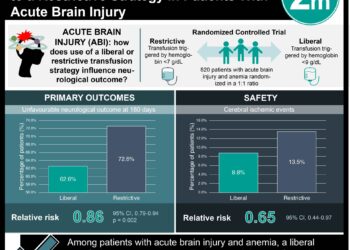Clinical decision tool may discriminate need for ICU in children with traumatic brain injury and intracranial injury
1. Based on this secondary analysis of a prospective cohort study, certain clinical features, including lower GCS score, and head CT findings, including midline shift, depressed skull fracture and epidural hematoma, were predictive of need for intensive care unit (ICU) in children with mild traumatic brain injury and intracranial injury.
2. The Children’s Intracranial Injury Decision Aid (CHIIDA) score (0 to 24 points) was based on the aforementioned factors, and had a negative predictive value (NPV) of requiring ICU with 0 points of 98.8%. Any score greater than zero, however, was not helpful in determining the appropriate disposition for the patient, meaning that there may still be an overuse of resources when using this tool.
Evidence Rating Level: 2 (Good)
Study Rundown: There has been an increasing understanding of the risks and consequences of mild traumatic brain injury (mTBI) and intracranial injury (ICI). However appropriate, evidence-based risk assessment scores to be used with computer tomographic (CT) imaging have not been created. These scores may improve patient safety and appropriation of resources. This retrospective analysis of the Pediatric Emergency Care Applied Research Network (PECARN) head injury cohort study aimed to derive a risk score predicting the need for the ICU in children with mTBI and ICI.
For the composite outcome of need for ICU, neurosurgical intervention, intubation, and death from TBI, the only clinically significant variable was lower GCS score. CT head predictors included midline shift, presence of a depressed skull fracture, and epidural hematoma. Using this data, the authors created the Children’s Intracranial Injury Decision Aid (CHIIDA) score, ranging from 0 to 24 points. The NPV of requiring the ICU with score 0 points was 98.8%. The strength of this study was the use of a large pediatric cohort. However, the poor positive predictive value of the score limits its use in determining the disposition for many of the patients with mTBI and ICI.
Click to read the study, published in JAMA Pediatrics
Relevant Reading: Trends in Hospitalizations Associated With Pediatric Traumatic Brain Injuries
In-Depth [retrospective cohort study]: The PECARN is a prospective pediatric head injury cohort that enrolled patients from 25 North American emergency departments from 2004 to 2006. These patients were 18 years or younger with mTBI (GCS13-15) and ICI found on CT. The cohort data was analyzed for the primary composite outcome of neurosurgical intervention, intubation for more than 24 hours for TBI, or death from TBI. The data was analyzed from May 2015 to October 2016 using multivariate logistic regression to identify risk factors that accurately predicted this outcome. The C-statistic was then used to determine the model’s performance and accuracy by examining both discrimination and calibration. The risk score was internally validated using 10-fold cross-validation methods. This led to the Children’s Intracranial Injury Decision Aid (CHIIDA) score.
Of the 15 162 children with GCS 13-15 head injuries, 839 (5.5%) had ICI. Of those, only 73 (8.7%) experienced the primary outcome. Within this sample, risk factors associated with the primary outcome were: GCS score (OR 3.4; 95% CI 1.5-7.4 for GCS score 13 vs 15), midline shift on CT (OR 6.8; 95% CI 3.4-13.8), depressed skull fracture (OR 6.5; 95% CI 3.7-11.4) and epidural hematoma (OR 3.4; 95% CI 1.8-6.2). The model C-statistic was 0.84. The CHIIDA score ranged from 0-24 points: midline shift, 7 points; depressed skull fracture, 7 points; epidural hematoma, 5 points, GCS of 13, 5 points; GCS of 14, 2 points. In predicting need for ICU admission, a cut off of >0 points was used to suggest admission to ICU with a sensitivity of 93.2%, NPV of 98.8%. Using this cutoff, the authors suggested that 51.3% ICU admissions would be avoided. Using a cutoff of 2 points the authors suggested that 65.4% of ICU admissions would be avoided. The CHIIDA score, however, was not able to accurately discriminate disposition.
Image: PD
©2017 2 Minute Medicine, Inc. All rights reserved. No works may be reproduced without expressed written consent from 2 Minute Medicine, Inc. Inquire about licensing here. No article should be construed as medical advice and is not intended as such by the authors or by 2 Minute Medicine, Inc.

![2MM: AI Roundup- AI Cancer Test, Smarter Hospitals, Faster Drug Discovery, and Mental Health Tech [May 2nd, 2025]](https://www.2minutemedicine.com/wp-content/uploads/2025/05/Untitled-design-350x250.png)





